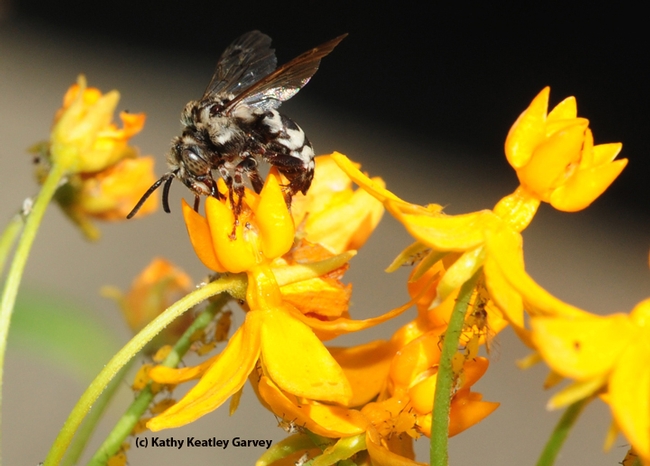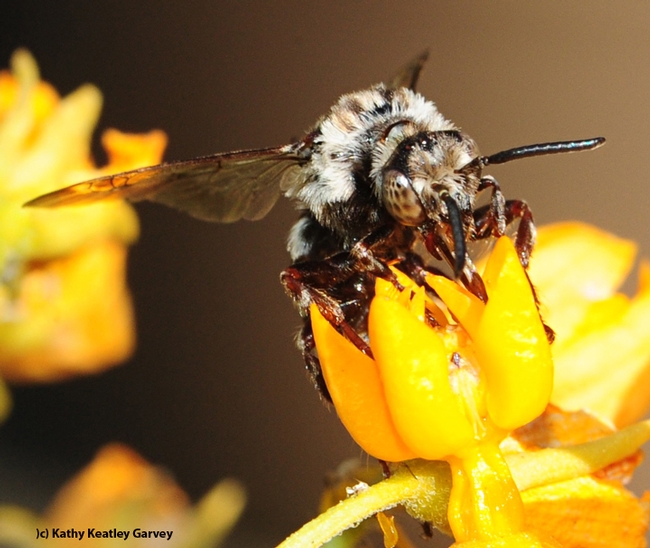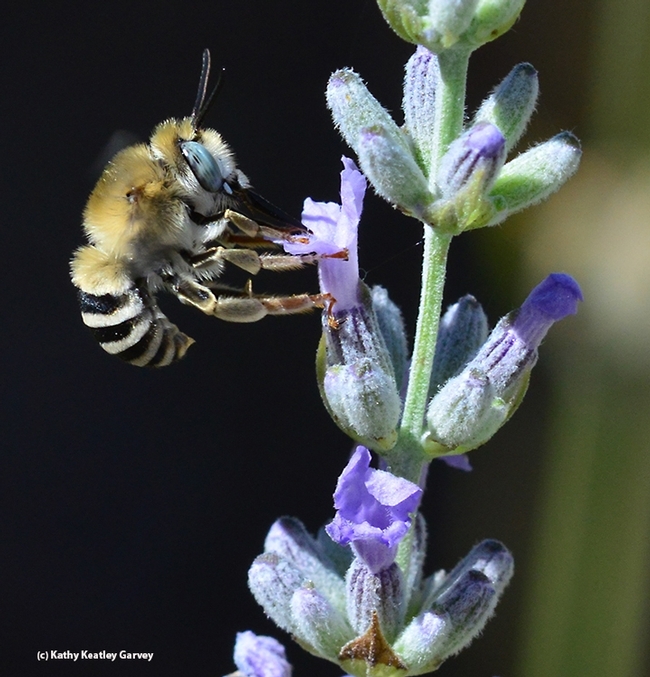- Author: Kathy Keatley Garvey
Ready or not, here I come!
"Wait, can you slow down a bit?" I ask. "I can't focus when you move so fast!"
No, sorry! I'm in a hurry!
Anthophora urbana, a solitary, ground-nesting bee, frequents our garden to forage on the catmint (Nepeta) and lavender (Lavandula). This bee is also called an urbane digger bee (see BugGuide.net).
This one encountered a honey bee, partly obscured by the foliage, but neither seemed bothered.
California is home to more than 1600 wild bees, including A. urbana, according to the University of California-authored book, California Bees and Blooms: A Guide for Gardeners and Naturalists (Heyday). They "populate and pollinate our gardens, fields, and urban green spaces," the authors say.
That they do. And there's a very good reason why this bee is photographed more often on flowers than in flight.
Sorry, I'm in a hurry!
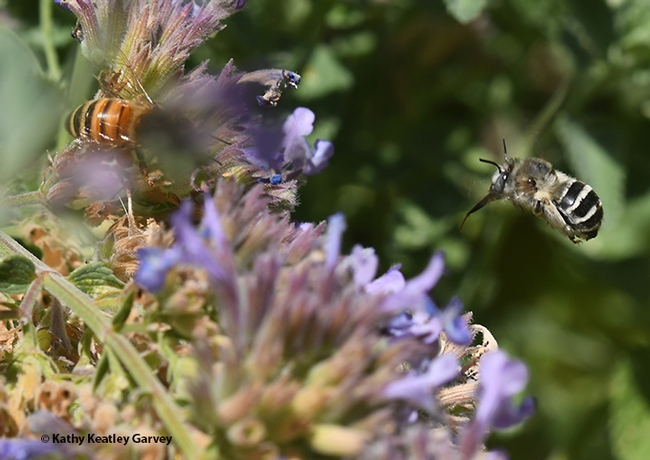
- Author: Kathy Keatley Garvey
Ever seen a cuckoo bee?
They're also called parasitic bees or "kleptoparasites" or "cleptoparasitises."
They cannot carry pollen (no apparatus) and do not construct their nests. They lay their eggs in the nests of their hosts and then eat the food meant for the hosts. Or as the late Robbin Thorp, distinguished emeritus professor of entomology at UC Davis, told us: "They eat the provisions, a pollen ball meant for the host offspring, and kill and eat the host larvae."
We've been watching a cuckoo bee, Xeromelecta californica, a parasite of the digger bee, Anthophora, as it forages on the African blue basil.
We've also been watching Anthophora urbana foraging on the basil. When the female leaves her nest to gather more food, the cuckoo bee takes the opportunity to lay an egg in her nest.
Sneaky, aren't they?
Very.
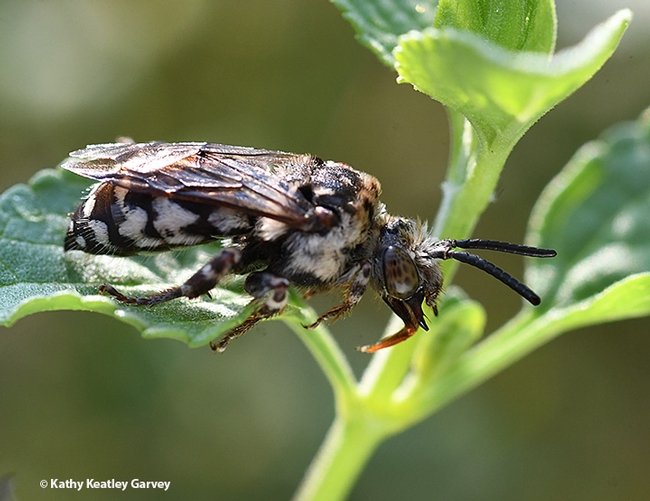
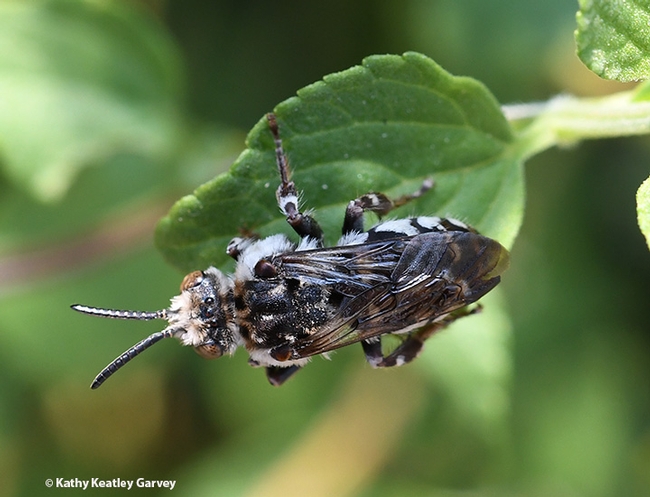
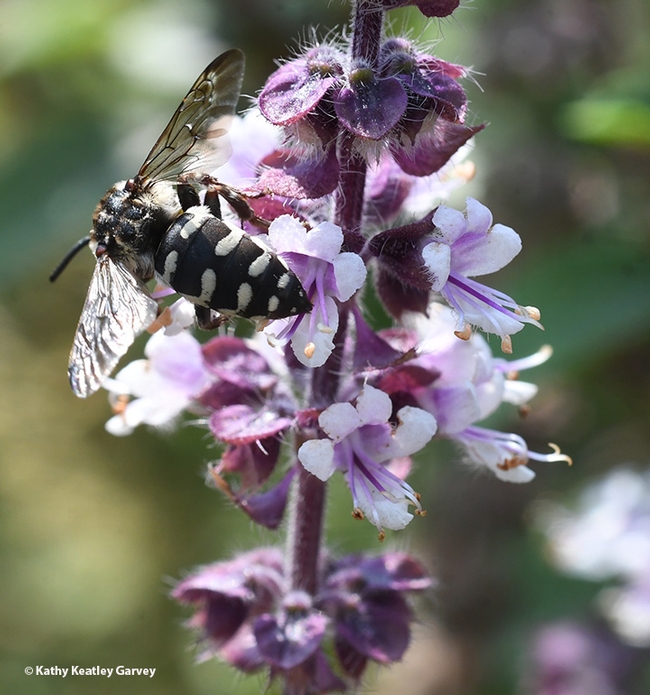
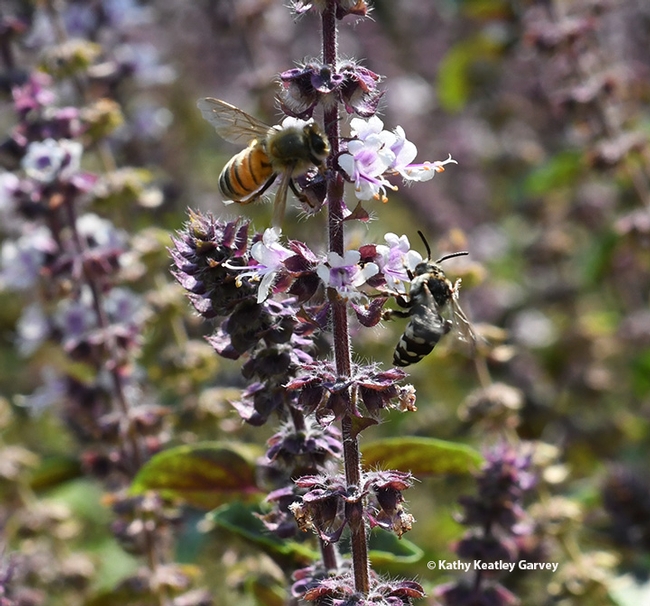
- Author: Kathy Keatley Garvey
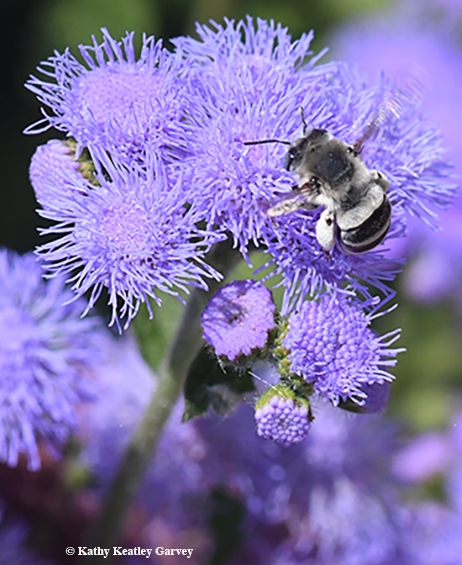
And sometimes it's too good to be true.
We were visiting the Sunset Gardens at the Sonoma (Calif.) Cornerstone on Sunday--marveling at the brilliant blue floss flowers, Ageratum houstonianum 'Blue Horizon'--when a bee with the familiar black and white abdominal stripes streaked by.
It was a digger bee, Anthophora urbana, a speedy bee we've bee admiring for years. We watched this one, a female, hover in front of a blossom for a couple of seconds--just enough time to grab four photos.
This is a native bee, smaller than a honey bee, that nests in the ground and transports pollen on its hind legs. It emerges early in the year, from early spring to summer, depending on the species, according to the authors of California Bees and Blooms: A Guide for Gardeners and Naturalists.
Its floral hosts include catmint (Nepeta), sage (Salvia chamaedryoides and Salvia mellfera), lavender (Lavandula spp.), phacelia (Phacelia tanacetifolia) and toadflax (Linaria purpurea).
This one was nectaring on a member of the aster family. Ageratum houstonianum, an annual.
According to the Missouri Botanical garden, the plant's genus name "presumably comes from the Greek a meaning not and geras meaning old age because the flowers hold their color for a long time." The species name honors Scottish surgeon and botanist William Houston (1695-1733) who collected plants in Mexico, West Indies and South America.
Want to know more about native bees? The book, California Bees and Blooms: A Guide for Gardeners and Naturalists, is a must-have. Published by Heyday Press, it's the work of Gordon Frankie, Robbin Thorp, Rollin Coville, and Barbara Ertter, all professionals affiliated with the University of California--(Frankie, Coville and Ertter, UC Berkeley, and Thorp, UC Davis who received his doctorate from UC Berkeley).
They also published a pocket guide, Common Native Bees in Gardens of California, available for purchase on the UC ANR website.
Are these Anthophora bees as fast as everyone says they are?
Yes, they are.
The authors wrote: "These bees fly so fast, you often only see a grey streak zoom by."
Make that a black-and-white streak that's moving so fast it appears grey.
(Editor's note: Photographer stopped the action with a Nikon D500 mounted with a 105mm macro lens: shutter speed, 1/3200 of second, f-stop 10; and ISO, 1250.)
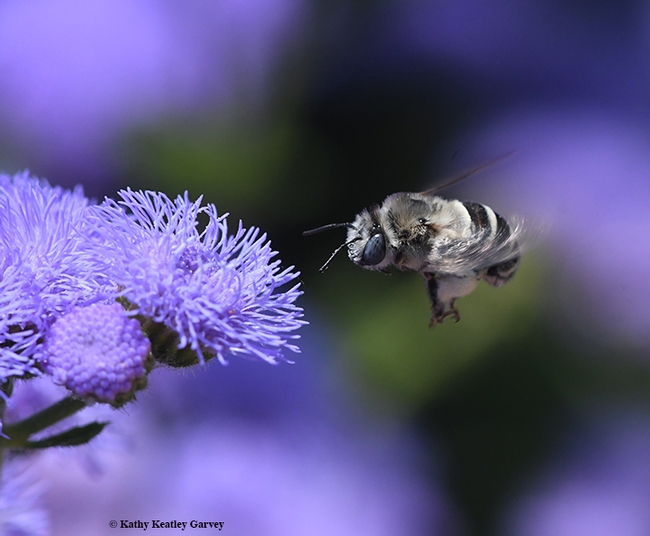
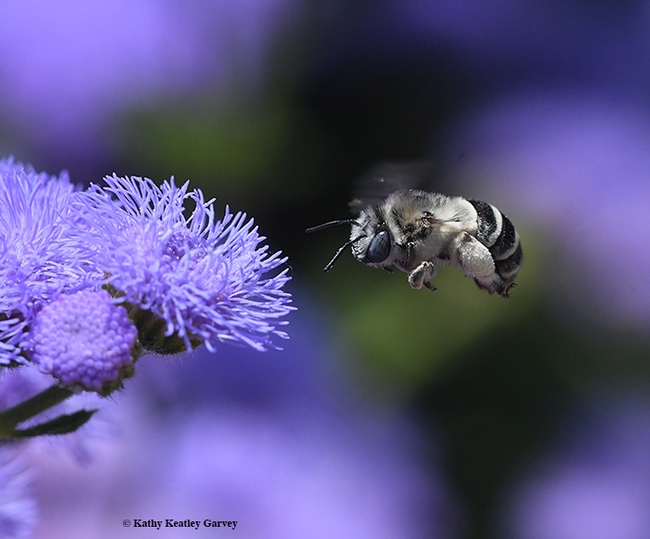
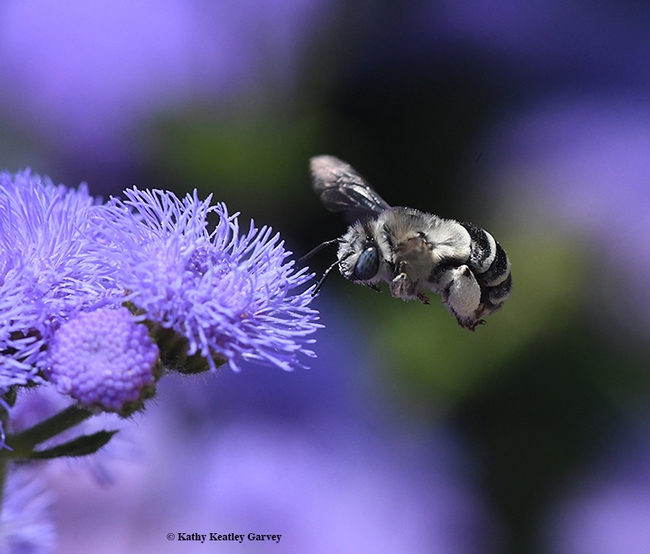
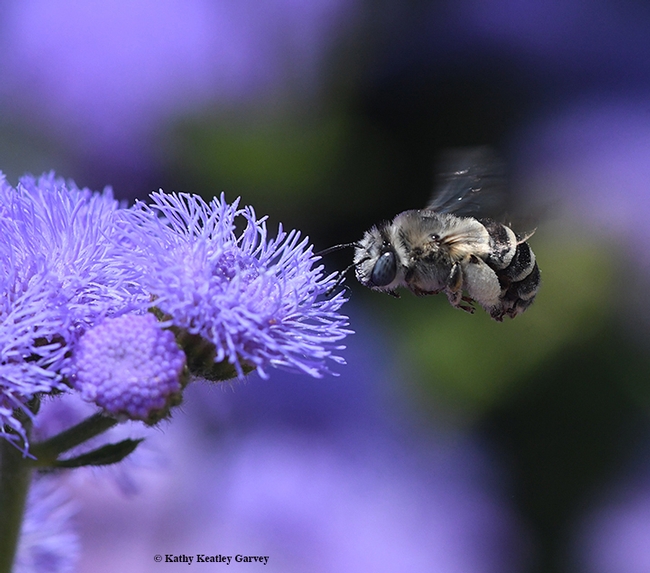
- Author: Kathy Keatley Garvey

Bees and blister beetles, yes.
We remember writing about her work in April of 2013 when she addressed the Nor Cal Entomology Society (now folded) about her research on how blister beetle nest parasites cooperate to mimic the sex pheromone of a digger bee. She had just returned from the Mojave National Preserve, tracking the solitary bee Habropoda pallida and its nest parasite, a blister beetle, Meloe franciscanus.
Fascinating research! Saul-Gershenz, who grew up in New York, studies the chemical ecology and parasite-host interactions of solitary native bees and their nest parasites across the western U. S., including the coastal sand dunes of Oregon and the Mojave Desert in south-central California.
"The solitary bee is the first native bee to emerge in the spring on the Kelso Dunes in the Mojave National Preserve," she told us. “The adult beetles emerge on the dunes in the winter months at Kelso Dunes and feed exclusively on the leaves of Astragalus lentiginosus which leafs out in January."
The bee's emergence is generally synchronized with the onset of blooms of the Borrego milkvetch, which is the sole host plant of adults of the blister beetle at Kelso Dunes.
Basically, the larvae of the parasitic blister beetle produce a chemical signal or allomone, similar to that of a female bee's pheromone to lure males to the larval aggregation. The larvae attach to the male bee on contact and then transfer to the female during mating. The end result: the larvae wind up in the nest of a female bee, where they eat the nest provisions and likely the host egg.
Leslie is now Dr. Saul-Gershenz. She received her doctorate in entomology in May 2017. And on Wednesday, Oct. 18, she will share her research at her exit seminar, "Host Range Evolution of the Bee Parasite Meloe franciscanus," set from 4:10 to 5 p.m. in 122 Briggs Hall, Kleiber Hall Drive.
"We report that different populations of M. franciscanus exhibit local adaptations that mimic both the behaviors and the chemical composition of the sex pheromones of locally available bee host species," she writes in her abstract. "We compared a population of M. franciscanus larvae, known as triungulins, parasitizing nests of Habropoda miserabilis (Hymenoptera: Apidae) from the coastal sand dunes of Oregon with a population parasitizing the congener H. pallida in the Mojave Desert in south-central California. We determined that M. franciscanus populations are the same species using molecular analyses.
Working in collaboration with the Neal Williams bee lab and the Steve Nadler molecular lab in the UC Davis Department of Entomology and Nematology, she and chemical ecologist Jocelyn Millar at UC Riverside found that multiple populations of the blister beetle Meloe franciscanus are locally adapted to different bee hosts in different allopatric populations. (Professor Williams is a pollination ecologist, and Nadler is a nematologist and chair of the department.)
The UC Davis evolutionary ecologist also explored which functional traits of hosts are useful for predicting parasite host range. In another study, she brought together a dream team of bee biologists and received funding from the Bureau of Land Management to study the impact of utility-scale solar development on desert bees. This study documented that these landscapes are biologically rich, even in drought years, and contain a minimum of 114 species of bees including six undescribed species of bee.
The significance of her work?
"Our research has added to the understanding of the communication signals of bees in the genus Habropoda," she related. "We now know that they use long-chain hydrocarbons for the female sex attractant and vary the position of the double bounds in different components and vary proportions of these components to avoid cross attraction among closely related species. Parasites co-opt this communication channel to deceive male bees in the Meloe-Habropoda system.
"In our host functional trait research we show that annual host abundance and host abundance from year to year, as well as local temporal overlap are highly predictive of host range."
Results on the impact of utility-scale solar development on desert bees showed high bee species diversity in the Mojave and western Sonoran region. "This suggests the importance of careful regional planning and additional research to protect this area of significant floral and fauna biodiversity," she said.
Future plans? To continue her research.
Leslie Saul-Gershenz, recipient of numerous grants and author of a number of publications ranging from peer-reviewed papers to books, is the co-founder of the Bay Area-based SaveNature.Org and director of Research and Conservation (1988 to present). The international conservation consortium works with partners to protect ecosystems around the world.
She is also a 2004 graduate of The Bee Course, an intensive 10-day workshop sponsored by the American Museum of Natural History at the Southwestern Research Station, Portal, Ariz. One of the instructors is Robbin Thorp, distinguished emeritus professor of entomology at UC Davis, also one of her many collaborators.
Among her other current collaborators: scientists Lynn Kimsey, Neal Williams, Tom Zavortink, Rebecca Hernandez, all of UC Davis; Terry Griswold, USDA-ARS, Bee Biology Lab; Monica Geber, Cornell University; and John Ascher, National University of Singapore.
Her next presentations of her research will be at the Entomological Society of America's annual conference, "Ignite, Inspire, Innovate," scheduled Nov. 5-8 in Denver,Colo., and the California Native Plant Society Conservation Conference, scheduled Feb. 1-3, 2018 in Los Angeles.
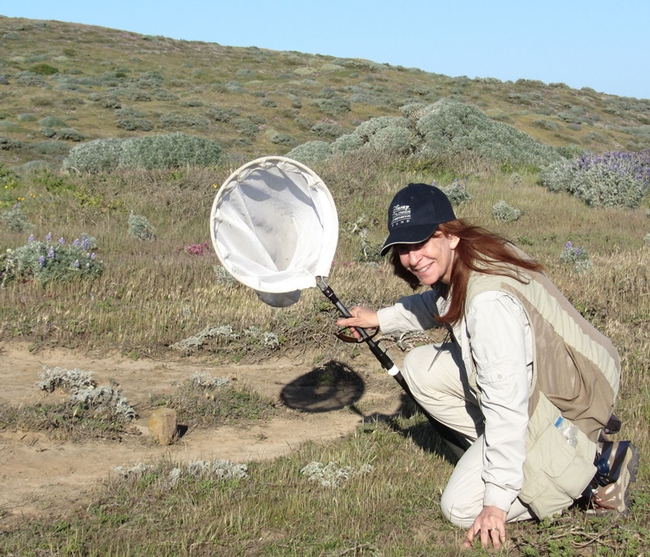
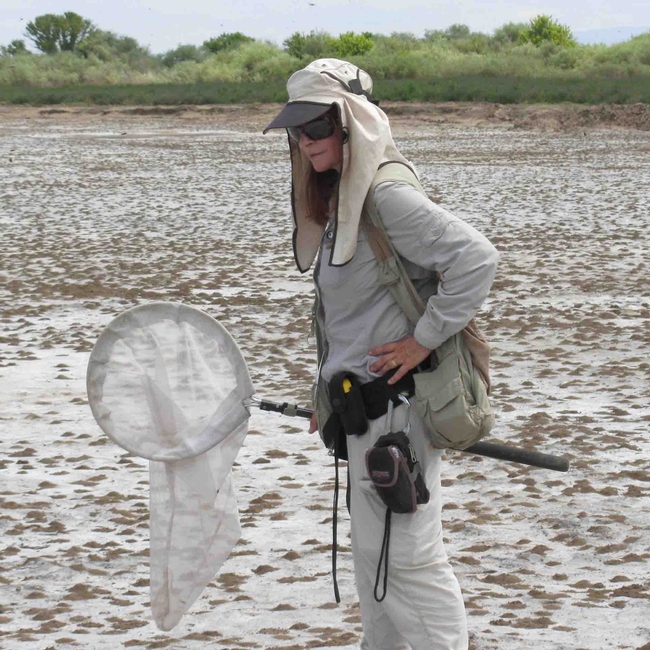
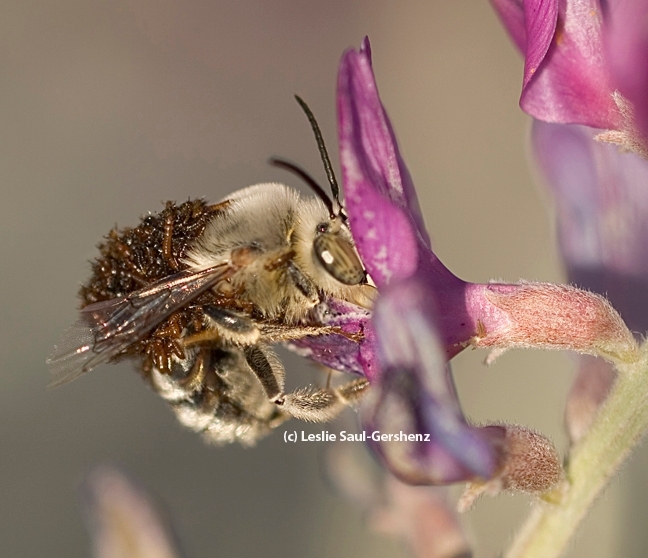
- Author: Kathy Keatley Garvey
You could call it a slacker, a deadbeat, a moocher, a sponger, or a loafer.
Or you could call it a cuckoo bee.
Take the cuckoo bee, Xeromelecta californica, a parasite of the digger bee, Anthophora.
When the female Anthophora leaves its nest to collect more pollen, the female cuckoo bee sneaks in and lays an egg.
"When the host female seals her nest, it seals the doom of her own offspring," distinguished emeritus professor Robbin Thorp of the UC Davis Department of Entomology and Nematology told the crowd at last week's 40th annual Western Apicultural Society meeting, held at UC Davis. They eat the provisions, a pollen ball meant for the host offspring, and kill and eat the host larvae.
The cuckoo bee offspring emerge.
Thorp, co-author of California Bees and Blooms: A Guide for Gardeners and Naturalists, also called attention to their "pointy abdomen" and "wasp-looking appearance."
But they are bees--cuckoo bees. They're also called parasitic bees or "kleptoparasites" or "cleptoparasitises."
They have no pollen-carrying/collecting apparatus, like a scopa, because they don't need any, Thorp said, just as they do not construct their own nests.
If you look around a pollinator garden, you just might sight some cuckoo bees. Last week we saw a Xeromelecta californica (as identified by Thorp and Lynn Kimsey, director of the Bohart Museum of Entomology and UC Davis professor of entomology). It was sipping nectar from a tropical milkweed, Asclepias curassavica.
We've also spotted Anthophora urbana nectaring on our lavender.
One thing's for certain: a cuckoo bee didn't lay its eggs in the Anthophora nest that time or the urbana wouldn't have been there.
